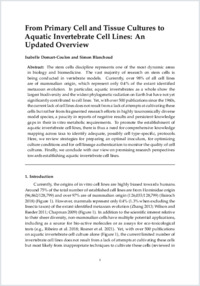From Primary Cell and Tissue Cultures to Aquatic Invertebrate Cell Lines: An Updated Overview
DOKPE
- Domart-Coulon , Isabelle ORCID Muséum National d’Histoire Naturelle, Paris
- Blanchoud, Simon ORCID University of Fribourg
- 2022
Published in:
- Advances in aquatic invertebrate stem cell research. - MDPI. - 2022, p. 1-64
English
The stem cells discipline represents one of the most dynamic areas in biology and biomedicine. The vast majority of research on stem cells is being conducted in vertebrate models. Currently, over 98% of all cell lines are of mammalian origin, which represent only 0.4% of the extant identified metazoan evolution. In particular, aquatic invertebrates as a whole show the largest biodiversity and the widest phylogenetic radiation on Earth but have not yet significantly contributed to cell lines. Yet, with over 500 publications since the 1960s, the current lack of cell lines does not result from a lack of attempts at cultivating these cells but rather from fragmented research efforts in highly taxonomically diverse model species, a paucity in reports of negative results and persistent knowledge gaps in their in vitro metabolic requirements. To promote the establishment of aquatic invertebrate cell lines, there is thus a need for comprehensive knowledge mapping across taxa to identify adequate, possibly cell type-specific, protocols. Here, we review strategies for preparing an optimal inoculum, for optimizing culture conditions and for cell lineage authentication to monitor the quality of cell cultures. Finally, we conclude with our view on promising research perspectives towards establishing aquatic invertebrate cell lines.
- Faculty
- Faculté des sciences et de médecine
- Department
- Département de Biologie
- Language
-
- English
- Classification
- Biological sciences
- License
- License undefined
- Open access status
- bronze
- Identifiers
- Persistent URL
- https://folia.unifr.ch/unifr/documents/319560
Other files
Statistics
Document views: 51
File downloads:
- p_styletextalign_leftfrom_primary_cell_and_tissue_cultures_to_aquatic_invertebrate_cell_lines_an_updated_overviewp6.pdf: 216
- tablea2.xlsx: 31

